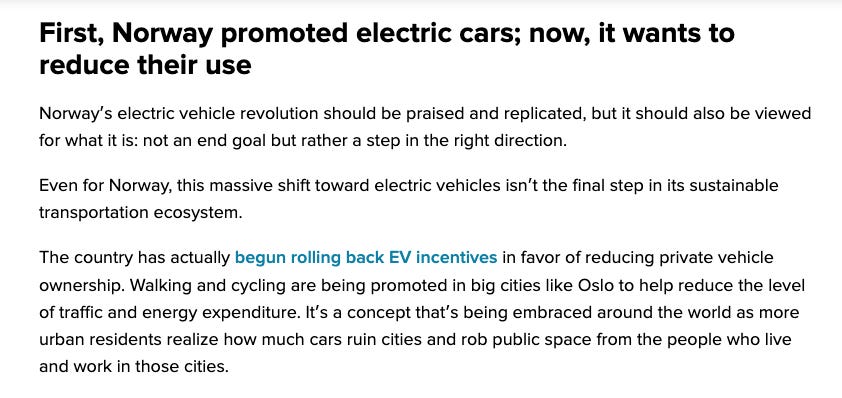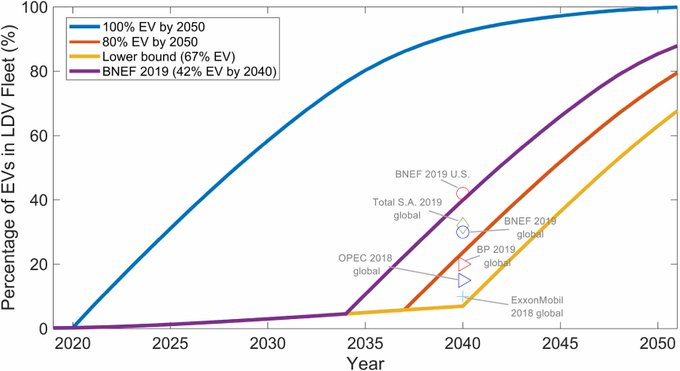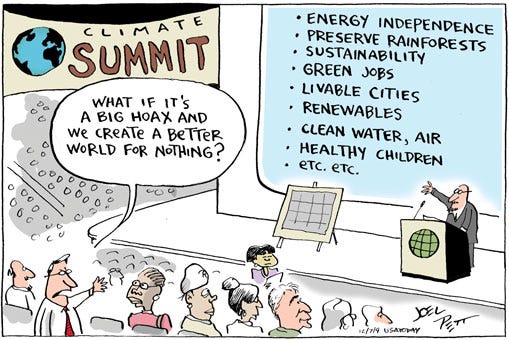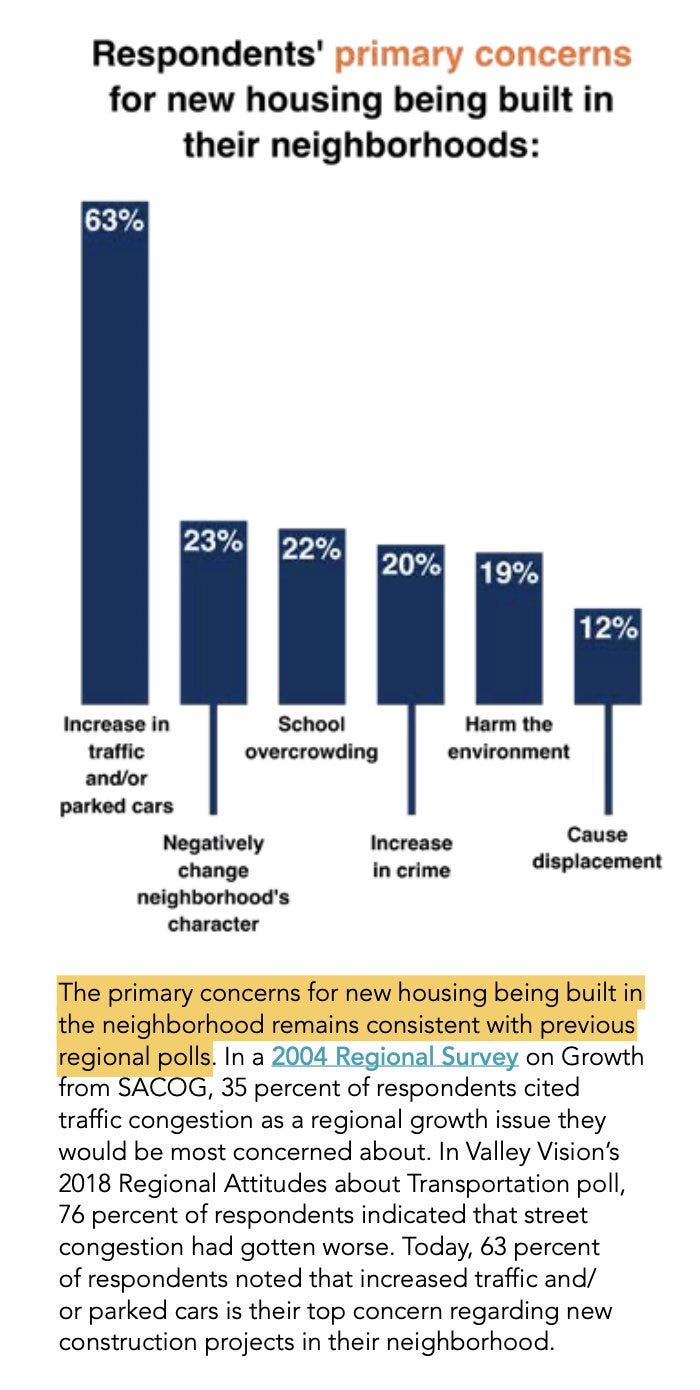Everything Noah Smith Gets Wrong about EVs
Noah is right -- but only on the things he's right about.
It’s time for another climate reality post! At the end of a much-needed vacation last week, I was pleasantly surprised to see that my friend
had written a lengthy post detailing all the ways he thinks the critics of electric vehicles are wrong — and he included me as one of the “critics who are wrong,” hence my interest in engaging with it here.In typical Noah Smith fashion, it’s a thoughtful and painstakingly-cited piece. Noah is a talented writer and economist and I’d not expect anything less from him. So, I’ll start with a broad stipulation: None of the arguments he makes seem to have any major flaws. I’d quibble with a couple of the details — electric car dependency is likely to be just as expensive as gasoline car dependency, for example — but as I’ll show in this post, the debate about the cost of ICE vs electric cars is not really germaine to the climate debate.
In any event, Noah’s take is a great primer on why EVs are, without question, the number two solution for the future of private, clean transportation (electric bikes are number one and are not likely to have serious competition).
My interest is not in this “techno-optimist” view; my interest is in how this relates to action on climate change, on urban health and safety, and on housing affordability.
My aim is to show why EV techno-optimists are, in fact, impeding progress on all three of these vital topics, and that if they actually care about climate, safety, and affordability, they’ll temper their triumphalism a bit.
Passing Through Oslo
As it turns out, I was passing through Oslo, Norway, when I saw Noah’s post. I was sitting on a bench overlooking the fjord, surrounded by thousands of car-free Oslovians strolling along the water, riding their bikes down extensive bike lanes, and lazing in the May sunshine. You see, Oslo has largely banned cars from its downtown, and is expanding the areas where cars will either be banned, or heavily regulated.
Why is the capital of the world’s leading electric car market cracking down on cars? Two reasons: Livability, and climate change.
One thing I love about developed-world cities with public spaces — it’s easy to catch up on reading. You see, downtown Oslo is virtually silent. That’s because there is no car traffic, which is the leading source of deadly noise pollution (not to mention, violent death and injury) in most urban environments.
Anyway, sitting in the sunshine and basking in the glory of a quiet, car-free urban area, the piece I was thinking about writing was a comparison between Oslo and Seattle, Washington. Oslo, at 60 degrees north, is one of the northernmost major cities on earth. It’s a wealthy, waterside city situated on a fjord with hilly terrain and substantial mountains in the near-distance.
Seattle, at 47 degrees north, is the northernmost major city in the 48 contiguous United States. It’s also a wealthy, waterside city situated on a fjord with hilly terrain and substantial mountains in the near-distance.
Seattle has a population of 733,000 on 83 square miles, and Oslo has a population of 1 million on 50 square miles. Make a mental note of this, as it’s highly relevant to the conclusion …
What got me thinking: Oslo and Seattle have a lot in common, except when it comes to cars.
(Parenthetical: You’ll often hear Americans of a car-oriented persuasion argue that it’s not fair to compare U.S. cities to EU cities, since those cities are “older” and were “built before the car.” It’s a shibboleth, as it’s false in most cases — most EU cities came to be utterly dominated by cars by the 1960s and 70s; so generally, you should dismiss these people as simply defending their own preference for driving. They know not of what they speak).
This is certainly the case in the comparison between Oslo and Seattle, as is easily proven by recent history.
You see, Oslo’s waterfront used to be dominated by a freeway and industrial zone. But then, city leaders got serious about three issues: Housing, livability, and climate change.
You’ll never guess what happened next:
The transformation of downtown Oslo from highway sacrifice zone and industrial wasteland to thriving, car-free, human-centered city was quite deliberate, and quite specifically a part of the city’s efforts on climate change — but also, on housing and livability.
“Fjordbyen showcases systemic thinking for city planners, demonstrating how a positive cityscape can be created through increased connectivity between different districts within a city. Placing people at the heart of the development plans may also have a positive effect on the overall social dynamics in the city over time.”
So, that’s Oslo, the capital of the world’s largest, most successful electric car market, where they’re already in the process of banning cars in urban areas and reducing electric car incentives in order to address climate change and make their cities more sustainable, affordable, and livable.
How about Seattle?
Welp.
Point of fact, Seattle’s situation is pretty typical of a US city. The thing to keep in mind is that transportation departments in the United States exist primarily as adjuncts of the car/oil industry, and their purpose, from the perspective of an urbanist who cares about climate change and human health (vis the U.S.’ status as the developed nation where you’re most likely to be maimed or killed by a driver), is to destroy cities, make them deadly and polluted, and all in the name of accommodating suburban commuters and their freeways and parking lots.
So, U.S. cities are governed by car-brained transportation leaders who have made pretty clear they don’t care that their designs and budgets are directly responsible for the leading cause of premature death in the country. That’s not news, but also, it’s not directly relevant to climate change. Point of fact, it is entirely possible — in fact, I’d put money on this being the default outcome, unless we intervene — that we’ll convert the US vehicle fleet to electric cars while maintaining our world-leading levels of deaths and maimings at the hands of violent drivers.
It’s the Stock and Flow, Stupid
But what about climate change? Well, about that — and this is really where
gets things 100% wrong:To address Noah’s claim directly: It is already physically impossible for one half of the US car fleet to be electric in 2030. There are 280 million passenger vehicles in the US, and in a banner year, the car industry sells 17 million new vehicles. If 100% of vehicles sold were electric in 2023, half the fleet would not be electric until 2032.
In 2022, 5% of new car sales in the U.S. were electric.
Basically, EVs are a great climate solution if — and ONLY if — we dramatically reduce the total number of cars, and the total number of miles driven, in the United States.
As of today, we will struggle to make half the fleet electric by 2040. In fact, I’ll bet Noah dinner that not even half of car sales will be electric in 2030.
Going back about ~ 10 years, the California Air Resources Board (CARB) started projecting fleet turnover rates from electric vehicle incentives and related policies, and what they found was … it’s going badly. To wit (from Ethan Elkind at the Center for Law, Energy and the Environment at UC Berkeley Law):
And (below post is from CARB’s former Deputy ExecutiveOfficer):
Essentially, California — which is the leading electric car market in the United States — is so far behind on the land use reforms we need to address the balance of climate pollution from cars, that, inclusive of full-fleet electrification, we have to reduce how much people drive by at least 25% by 2030.
To make matters worse, CARB, which administers the state’s electric vehicle incentives program, has done such a poor job doing so, they’ve likely increased how much we have to reduce driving beyond that 25% figure:
CARB has done little to measure the extent to which its incentive programs lead to emissions reductions by causing individuals and businesses to acquire clean vehicles that they otherwise would not.
As a result, CARB has overstated the GHG emissions reductions its incentive programs have achieved, although it is unclear by how much.
Back in 2020, Costa Samaras and his team at Carnegie Mellon extrapolated this “fleet turnover” problem across the US fleet. What they found: If we wanted to meet our existing climate targets, the deadline for 100% of new cars sales to be electric was … 2020:
The money tweet:
Not All Games are Zero Sum. But Land Use Is.
And thus we arrive at the nut of the problem with Noah’s post. As previously stipulated, he is largely correct on the merits of the argument he makes — that EVs are coming, that they will eventually become the standard car on earthly roads, that markets will figure out how to supply the necessary minerals and batteries and clean power etc.
But these are neither the concerns nor the arguments most urbanists have about EVs — at least, they’re not my concern. My concern is 1) climate change, and 2) urban livability/affordability. Electric cars could be a part of the solution here IF we effectively execute the balance of the solution set — namely, the Oslo approach (which also happens to be the Madrid and London and Paris and Milan and Amsterdam and Copenhagen and Berlin and Ljubljana and Vienna approach):
Ban or severely restrict cars in urban districts
Massively invest in walkability, safe bike infrastructure, transit, and dense housing
Make drivers pay the cost of driving
It’s this last piece that has me puzzled about Noah’s take, because usually, economists are in favor of allowing markets to find the price of things, and then reading prices for evidence of what people actually want, in order to craft optimal policies and shape markets accordingly.
But in the case of American car culture, we have the biggest market failure in human history. We subsidize cars to a degree that’s virtually unmatched on earth, to the tune of over $2 trillion per year, every year — and as a result of this big-government, anti-market intervention in transportation, Americans have the highest transportation costs in the developed world …
… specifically because we mandate car dependence, and ban housing in walkable neighborhoods. This, despite the fact that, according to all the data available from housing markets, many more Americans would prefer to live in dense, walkable neighborhoods than in car-dependent suburbs:
What electric cars unquestionably solve: Pollution for the share of trips that must be made in cars under a climate-safe future.
What they don’t solve: Any one of the several other steps we must take to achieve that climate-safe future.
Noah’s big blind spot here — and this is not a hit against him, it’s not his job to do this — but he doesn’t actually attend local planning meetings that discuss issues like parking reform, affordable housing, transit lanes, and safe streets. It is absolutely the case that, across the U.S., city leaders who oppose affordable housing, safe streets, and transit use the shibboleth argument — that we don’t need to change our urban land use, because electric cars will save us.
And, so far, they’re winning. Pedestrian deaths are on the rise, transit is in a death spiral, and housing affordability is struggling.
This is the path not only to continued traffic violence and unaffordable cities, it’s also the path to a failure on climate. That’s just math.
Ultimately, though, and to be completely blunt —I’m not inspired or concerned about climate math, or any math for that matter.
The Case for Cities That Don’t Suck
Imagine a city where children are routinely slaughtered while crossing the streets, and city leaders virtually make a show of not doing anything to change the conditions that led to their deaths.
Imagine a city that had 200 square miles set aside for car parking that also was home to 70,000 people with no housing at all, living on the streets.
Imagine a country that has no trouble providing 8 parking spaces for every car, but can’t figure out how to provide an affordable home for every resident.
Imagine a country that spends $3.5 trillion on car culture every year without even blinking an eye, but gets weeks of media coverage about the exorbitance of spending ~ $5 billion per year on a high-speed train.
That’s the United States. And on our current trajectory, we’ll get to keep these brutally inhuman and, in my opinion, immoral conditions — but, hey, they’ll be electrified!
Thanks, but no thanks. I officially do not want electric cars to merely replace the status quo of the trash heap that car culture has made of our cities.
I’ve worked on climate change for 20 years, and I’ll continue to do the work because I actually do care about the outcomes. But I have no interest in supporting a solution set that will further entrench the deadliest, most inequitable, expensive mode of transport ever created by humans. And not just because it won’t actually solve climate, but rather, I just don’t want to live in that world.
And we don’t have to. That’s ultimately why I’m a YIMBY. We have a vision of urban life that is actually affordable and pleasant, and, yeah, survivable. Nobody wants to live in a place where you risk death merely walking to the grocery store.
I’m glad to report, I’m not alone:
The truth is, the era of car dominance in U.S. cities is actually coming to an end. It doesn’t feel like it at this exact moment, but it’s a geometric certainty for any city that hopes to not go the way of Detroit.
That’s not to say we won’t see many U.S. cities stagnate and fail on the altar of car worship. In fact, some cities may very well end up slitting their own economic throats to defend their values, which are mostly just cheap/free parking spots:
To fully and finally answer Noah’s piece, we are in fact locked in a zero-sum battle between housing, car culture, and climate change, and car culture has to lose. So please do bring on all the electric cars, and speed it up if you’re able (they’re running way behind schedule).
But the climate-safe cities of the future will not be the car-dominated places they are today. They can’t be, and if those of us focused on climate, livability, and affordability have anything to say about it, they won’t be.






















